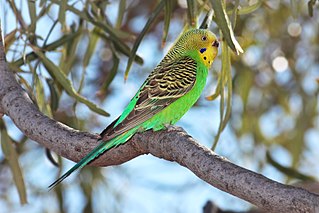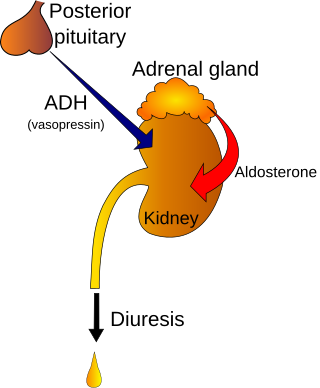Related Research Articles

Diabetes insipidus (DI), alternately called arginine vasopressin deficiency (AVP-D) or arginine vasopressin resistance (AVP-R), is a condition characterized by large amounts of dilute urine and increased thirst. The amount of urine produced can be nearly 20 liters per day. Reduction of fluid has little effect on the concentration of the urine. Complications may include dehydration or seizures.

Drinking is the act of ingesting water or other liquids into the body through the mouth, proboscis, or elsewhere. Humans drink by swallowing, completed by peristalsis in the esophagus. The physiological processes of drinking vary widely among other animals.

The budgerigar, also known as the common parakeet, shell parakeet or budgie, is a small, long-tailed, seed-eating parrot. Budgies are the only species in the genus Melopsittacus. Naturally, the species is green and yellow with black, scalloped markings on the nape, back, and wings. Budgies are bred in captivity with colouring of blues, whites, yellows, greys, and even with small crests. Juveniles and chicks are monomorphic, while adults are told apart by their cere colouring, and their behaviour.

Human vasopressin, also called antidiuretic hormone (ADH), arginine vasopressin (AVP) or argipressin, is a hormone synthesized from the AVP gene as a peptide prohormone in neurons in the hypothalamus, and is converted to AVP. It then travels down the axon terminating in the posterior pituitary, and is released from vesicles into the circulation in response to extracellular fluid hypertonicity (hyperosmolality). AVP has two primary functions. First, it increases the amount of solute-free water reabsorbed back into the circulation from the filtrate in the kidney tubules of the nephrons. Second, AVP constricts arterioles, which increases peripheral vascular resistance and raises arterial blood pressure.

Polyuria is excessive or an abnormally large production or passage of urine. Increased production and passage of urine may also be termed diuresis. Polyuria often appears in conjunction with polydipsia, though it is possible to have one without the other, and the latter may be a cause or an effect. Primary polydipsia may lead to polyuria. Polyuria is usually viewed as a symptom or sign of another disorder, but it can be classed as a disorder, at least when its underlying causes are not clear.

Thirst is the craving for potable fluids, resulting in the basic instinct of animals to drink. It is an essential mechanism involved in fluid balance. It arises from a lack of fluids or an increase in the concentration of certain osmolites, such as sodium. If the water volume of the body falls below a certain threshold or the osmolite concentration becomes too high, structures in the brain detect changes in blood constituents and signal thirst.
Polydipsia is excessive thirst or excess drinking. The word derives from the Greek πολυδίψιος (poludípsios) "very thirsty", which is derived from πολύς + δίψα. Polydipsia is a nonspecific symptom in various medical disorders. It also occurs as an abnormal behaviour in some non-human animals, such as in birds.

Demeclocycline is a tetracycline antibiotic which was derived from a mutant strain of Streptomyces aureofaciens.
Neuroendocrinology is the branch of biology which studies the interaction between the nervous system and the endocrine system; i.e. how the brain regulates the hormonal activity in the body. The nervous and endocrine systems often act together in a process called neuroendocrine integration, to regulate the physiological processes of the human body. Neuroendocrinology arose from the recognition that the brain, especially the hypothalamus, controls secretion of pituitary gland hormones, and has subsequently expanded to investigate numerous interconnections of the endocrine and nervous systems.

Forced molting, sometimes known as induced molting, is the practice by some poultry industries of artificially provoking a flock to molt simultaneously, typically by withdrawing food for 7–14 days and sometimes also withdrawing water for an extended period. Forced molting is usually implemented when egg-production is naturally decreasing toward the end of the first egg-laying phase. During the forced molt, the birds cease producing eggs for at least two weeks, which allows the bird's reproductive tracts to regress and rejuvenate. After the molt, the hen's egg production rate usually peaks slightly lower than the previous peak, but egg quality is improved. The purpose of forced molting is therefore to increase egg production, egg quality, and profitability of flocks in their second or subsequent laying phases, by not allowing the hen's body the necessary time to rejuvenate during the natural cycle of feather replenishment.
Nephrogenic diabetes insipidus, also known as renal diabetes insipidus, is a form of diabetes insipidus primarily due to pathology of the kidney. This is in contrast to central or neurogenic diabetes insipidus, which is caused by insufficient levels of vasopressin. Nephrogenic diabetes insipidus is caused by an improper response of the kidney to vasopressin, leading to a decrease in the ability of the kidney to concentrate the urine by removing free water.
Primary polydipsia and psychogenic polydipsia are forms of polydipsia characterised by excessive fluid intake in the absence of physiological stimuli to drink. Psychogenic polydipsia which is caused by psychiatric disorders, often schizophrenia, is often accompanied by the sensation of dry mouth. Some forms of polydipsia are explicitly non-psychogenic. Primary polydipsia is a diagnosis of exclusion.

Aquaporin-2 (AQP-2) is found in the apical cell membranes of the kidney's collecting duct principal cells and in intracellular vesicles located throughout the cell. It is encoded by the AQP2 gene.
Fanconi syndrome or Fanconi's syndrome is a syndrome of inadequate reabsorption in the proximal renal tubules of the kidney. The syndrome can be caused by various underlying congenital or acquired diseases, by toxicity, or by adverse drug reactions. It results in various small molecules of metabolism being passed into the urine instead of being reabsorbed from the tubular fluid. Fanconi syndrome affects the proximal tubules, namely, the proximal convoluted tubule (PCT), which is the first part of the tubule to process fluid after it is filtered through the glomerulus, and the proximal straight tubule, which leads to the descending limb of loop of Henle.

Abnormal behavior of birds in captivity has been found to occur among both domesticated and wild birds. Abnormal behavior can be defined in several ways. Statistically, 'abnormal' is when the occurrence, frequency or intensity of a behaviour varies statistically significantly, either more or less, from the normal value. This means that theoretically, almost any behaviour could become 'abnormal' in an individual. Less formally, 'abnormal' includes any activity judged to be outside the normal behaviour pattern for captive birds of that particular class or age. For example, running rather than flying may be a normal behaviour and regularly observed in one species, however, in another species it might be normal but becomes 'abnormal' if it reaches a high frequency, or in another species it is rarely observed and any incidence is considered 'abnormal'. This article does not include 'one-off' behaviours performed by individual birds that might be considered abnormal for that individual, unless these are performed repeatedly by other individuals in the species and are recognised as part of the ethogram of that species.

The condition known today as diabetes is thought to have been described in the Ebers Papyrus. Ayurvedic physicians first noted the sweet taste of diabetic urine, and called the condition madhumeha. The term diabetes traces back to Demetrius of Apamea. For a long time, the condition was described and treated in traditional Chinese medicine asxiāo kě. Physicians of the medieval Islamic world, including Avicenna, have also written on diabetes. Early accounts often referred to diabetes as a disease of the kidneys. In 1674, Thomas Willis suggested that diabetes may be a disease of the blood. Johann Peter Frank is credited with distinguishing diabetes mellitus and diabetes insipidus in 1794.
Frédéric Bremer was a pioneer in the field of neurophysiology, whose work specialized in the neural mechanisms involved in the sleep-wake cycle. His other works include research into aphasia and apraxia, the neurogenic origin of diabetes insipidus, the physiology of the cerebellum, and the neural control of muscular tone.

Adipsia, also known as hypodipsia, is a symptom of inappropriately decreased or absent feelings of thirst. It involves an increased osmolality or concentration of solute in the urine, which stimulates secretion of antidiuretic hormone (ADH) from the hypothalamus to the kidneys. This causes the person to retain water and ultimately become unable to feel thirst. Due to its rarity, the disorder has not been the subject of many research studies.
Chronic egg laying is a maladaptive, behavioural disorder commonly seen in pet birds which repeatedly lay clutches of infertile eggs in the absence of a mate. It is particularly common in cockatiels, budgerigars, lovebirds, macaws and amazon parrots. Birds exhibiting chronic egg laying behavior will frequently lay eggs one after the other without stopping to brood them once the typical clutch size for their particular species has been reached. Excessive egg laying places a strain on the hen's body, depleting resources such as calcium, protein and vitamins from her body and may lead to conditions such as egg binding, osteoporosis, seizures, prolapse of the oviduct, or peritonitis – which may lead to her death.
References
- ↑ "Food Toxicoses in Birds". Archived from the original on 2011-10-04. Retrieved 2011-10-04.
- ↑ "Parrots - Parrot Conservation - Breeding - The Parrot Society UK".
- ↑ Hardy, W.T. and Westbrook R.F. 1981. Lithium-induced polydipsia in birds: A comparative study and analysis of electrolyte excretion. Physiology and Behavior, 27: 575-583
- ↑ "Waterfowl diseases Domestic waterfowl Club". Archived from the original on 2011-04-29. Retrieved 2011-04-09.
- ↑ "HolisticBird and HolisticBirds". Archived from the original on 2012-03-22. Retrieved 2011-04-09.
- ↑ Ralph, C.L. 1960. Polydipsia in the hen following lesions in the supraoptic hypothalamus. American Journal of Physiology, 198:528-530
- ↑ Savory, C.J. and Mann, J.S., 1997. Is there a role for corticosterone in expression of abnormal behaviour in restricted-fed fowls? Physiology & Behavior, 62: 7-13
- ↑ Hamm, R.J., Porter, J.H. and Kaempf, G.L. 1981. Stimulus generalization of schedule-induced polydipsia. Journal of Experimental Analysis of Behaviour, 36: 93–99
- ↑ Palya, W.L. 1980. Stereotyped adjunctive pecking by caged pigeons. Animal Learning & Behavior, 8: 293-303
- ↑ "Factors Affecting Water Intake of Poultry".
- ↑ Minvielle, F., Grossmann R. and Gourichon, D., 2007. Development and performances of a Japanese Quail line homozygous for the diabetes insipidus (di) mutation. Poultry Science, 86:249-254